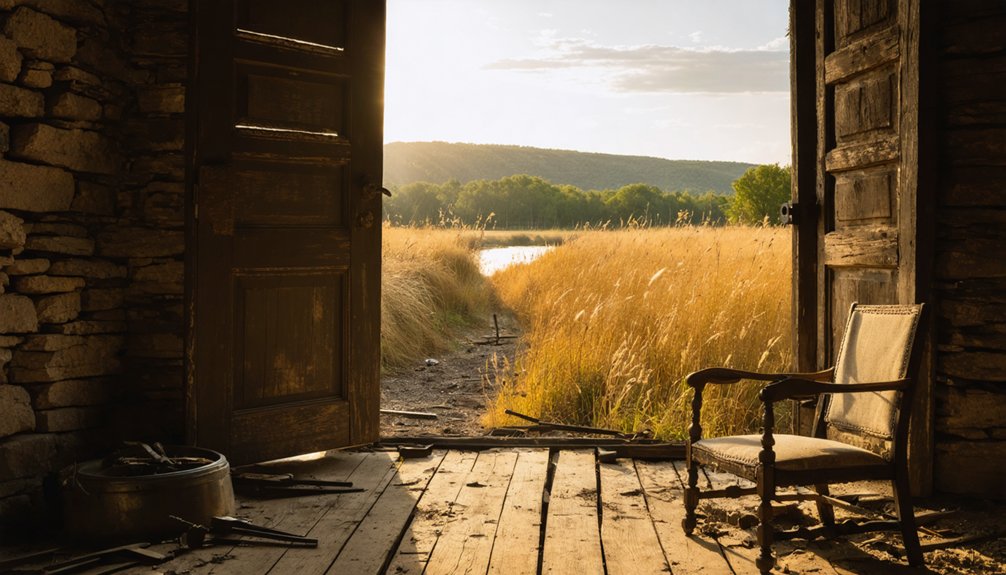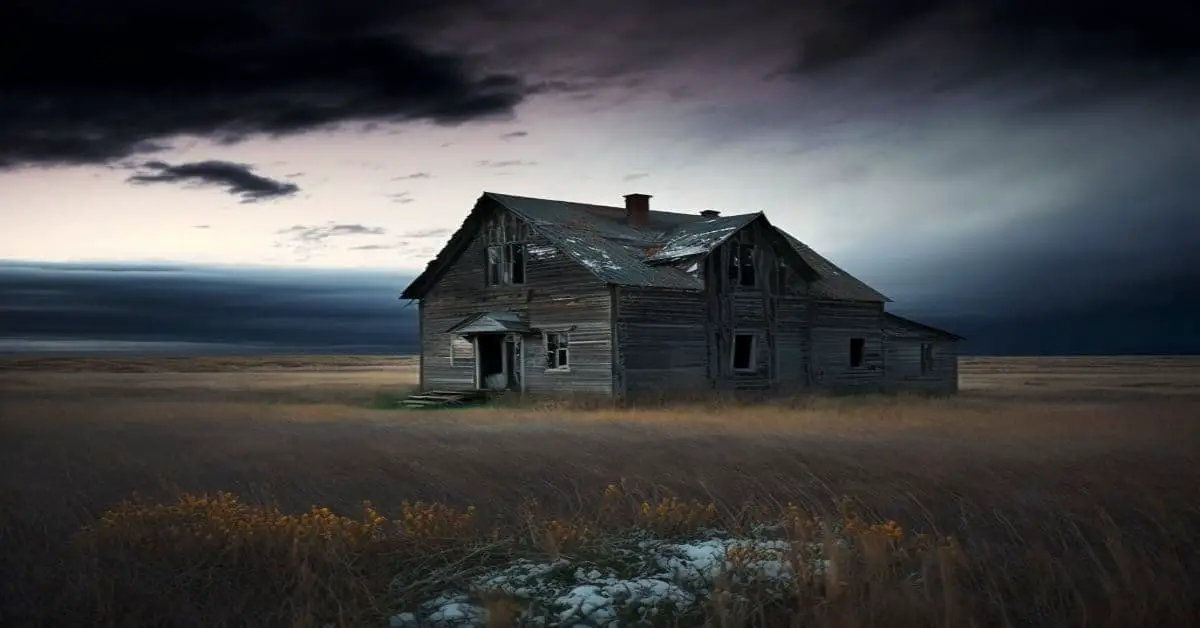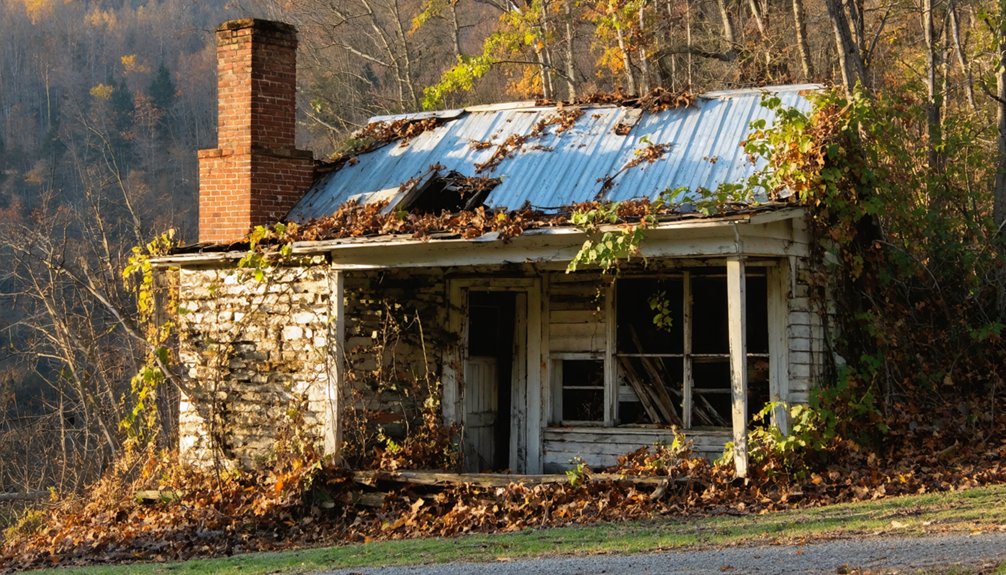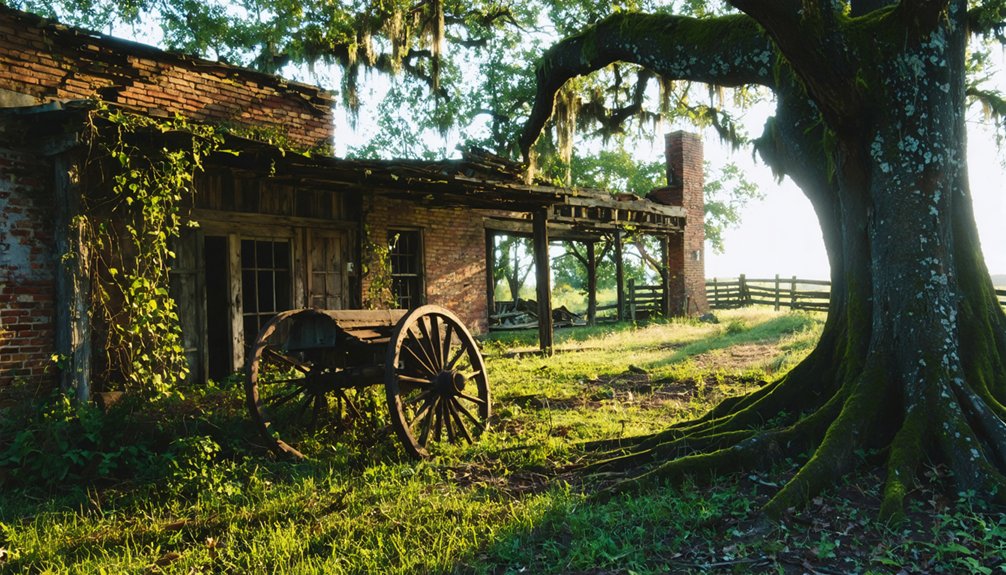You’ll find Rush’s haunting ruins nestled along Buffalo National River, where Arkansas’ largest zinc mining boom transformed farmland into a bustling community of 5,000 during World War I. The town’s zinc deposits, discovered by John Wolfer in the 1880s, sparked dramatic growth with 13 active mines and a thriving economy worth $800,000 by 1915. After zinc prices collapsed post-war, Rush declined into a ghost town, though its preserved structures and mining sites tell an incredible frontier tale.
Key Takeaways
- Rush was Arkansas’s largest zinc mining community, reaching a peak population of 5,000 during World War I before declining into a ghost town.
- The town’s prosperity ended after World War I when zinc prices plummeted, causing mass exodus and reducing population to 344 by 1920.
- The final marker of Rush’s transformation into a ghost town came in the 1950s when its post office closed permanently.
- Today, Rush is preserved within Buffalo National River Park, featuring historic mining ruins, interpretive trails, and guided tours.
- Abandoned mines, processing mills, and town structures remain as testament to Rush’s once-thriving zinc mining operations.
The Birth of a Mining Frontier
When John Wolfer stumbled upon a significant zinc deposit along Rush Creek in southern Marion County, he unknowingly sparked what would become Arkansas’s most productive zinc mining district.
You’ll find it fascinating that early prospectors initially mistook the ore for silver, triggering a rush of claims until they confirmed zinc’s true identity. George Chase’s acquisition of Wolfer’s claim laid the foundation for mining techniques that would shape the region’s future.
Early confusion over silver spurred Rush Valley’s mining boom, but zinc proved the real treasure beneath Arkansas’s rugged terrain.
As word spread of the discovery, prospectors flooded Rush Valley, demonstrating remarkable community resilience as they transformed this remote wilderness into a bustling frontier. Much like Colorado’s spring pole drilling, these early miners relied on primitive but effective techniques to extract resources. The most spectacular find was a 12,750-pound smithsonite mass that validated the region’s mineral wealth.
You can imagine the determination of these early settlers as they established mines, processing plants, and makeshift settlements along the Buffalo River, creating an economic hub from virtually nothing.
Zinc Mining’s Golden Era
During World War I, you’d have found Rush at its absolute peak, with ten mining companies operating thirteen developed mines to meet the massive wartime demand for zinc.
You could’ve seen the Morning Star Mining Company leading the charge, producing jaw-dropping specimens like the 12,750-pound pure smithsonite and the legendary “Jumbo” – a 6.5-ton raw ore that showcased the district’s incredible mineral wealth.
The wartime boom brought between 2,000 and 5,000 people to Rush, transforming this once-quiet valley into Arkansas’s zinc mining capital. Today, visitors can explore these preserved mining structures while hiking the Morning Star Loop trail. Unfortunately, the town’s prosperity was short-lived when zinc prices collapsed after the war.
World War Production Boom
The outbreak of World War I transformed Rush, Arkansas into a zinc-producing powerhouse as the military’s desperate need for brass shell casings and munitions box linings drove production to unprecedented levels.
You’ll find wartime logistics pushed local mines to their limits, with zinc concentrate output soaring from 1,000 to 6,815 tons by 1916. The number of operating mines tripled, and the valley’s value skyrocketed twelve-fold to nearly $800,000 in just one year. The rapid economic growth sparked new business development throughout Rush Valley.
During this period, Arkansas contributed five to six percent of the total U.S. zinc ore production, demonstrating the region’s strategic importance to the war effort.
- Mining operations expanded from 30 to 100 sites between 1914-1915
- Rush’s population boomed to an estimated 6,000 residents
- The Morning Star Mine became the district’s crown jewel
- Mills burned through 8 cords of wood daily to keep production moving
- Three major zinc smelters processed ore using Arkansas River Valley natural gas
Wealth From Mining Operations
From humble beginnings as farmland in the 1880s, Rush transformed into Arkansas’ premier zinc mining district, where prospectors like John Wolfer and George Chase laid the foundation for immense wealth generation.
Mining prosperity attracted thousands of workers, swelling the population to between 2,000 and 5,000 residents during the peak boom years.
You’ll find that Rush’s economic legacy was built on the incredible output of its 13 developed mines, operated by 10 different mining companies.
The Morning Star Mine exemplified this success, producing massive smithsonite specimens, including an astounding 12,750-pound piece.
The zinc ore’s value skyrocketed during World War I, as it was essential for brass production in ammunition and war materials, creating substantial wealth for the region’s mining operations.
The North Arkansas Lead district’s mining infrastructure and community buildings remain largely preserved, offering a rare glimpse into this important era of American industrial history.
The district was particularly known for its valuable yellow smithsonite, which miners nicknamed “turkey fat” due to its distinctive appearance.
Life During the World War I Boom
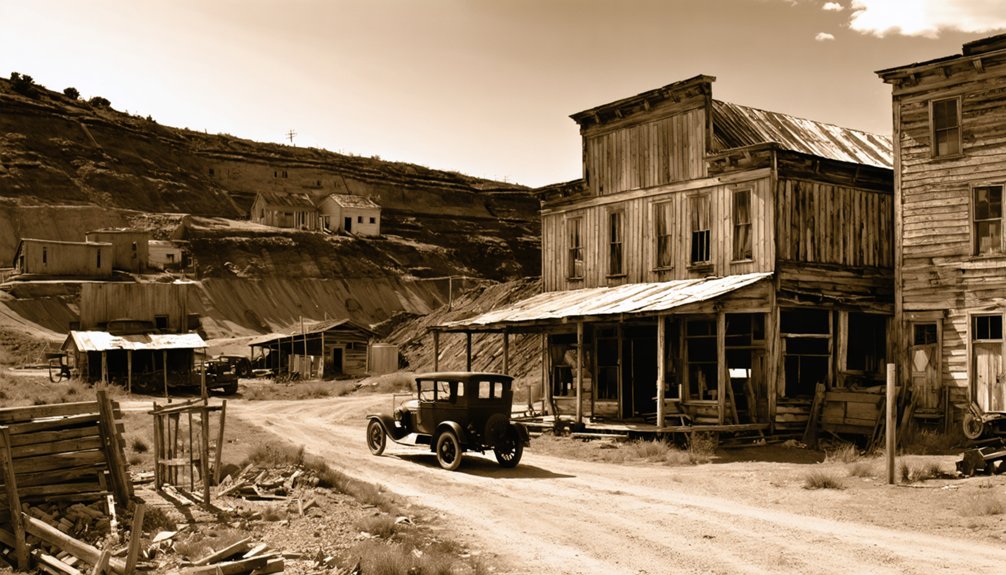
As World War I created unprecedented demand for zinc in munitions and galvanization, Rush transformed into Arkansas’s premier mining boomtown, with its population swelling to between 2,000 and 5,000 residents.
You’d have found remarkable community cohesion despite the challenging mountain conditions, as miners and their families built a thriving society centered around the mining operations.
Wartime resilience shaped daily life, with social activities revolving around work schedules and seasonal changes. The town’s historic structures, including homes and a general store building, remained inhabited well into the 1960s.
- Ten mining companies operated 13 developed mines throughout the valley
- Hotels, stores, and post offices served as essential community gathering spots
- Miners worked high on hillsides while processing mills operated below
- Diverse workforce included miners, millers, and service industry workers
- The Hicks family played a central role in community development
The Town’s Rise to Wealth
While Rush’s wartime prosperity marked its peak, the town’s path to wealth began decades earlier with an ironic twist of fate.
In the 1880s, prospectors rushed to the area chasing silver dreams, only to discover they’d stumbled upon something entirely different – rich zinc deposits. You’ll find it amusing that even their first smelter, built in 1886, revealed their mistake when it produced zinc oxide fumes instead of silver.
As word spread of the zinc discovery, you’d have seen the valley transform. Mining techniques evolved as claims dotted Rush Valley and Clabber Creek. Young boys earned 75 cents per day hauling ore loads from the mines.
The community dynamics shifted from individual prospectors to organized operations like the Morning Star Mining Company. Despite challenging transportation conditions, with ore hauled out by horse and mule teams, Rush’s mining industry flourished, drawing thousands to seek their fortune.
Daily Life in a Mining Community

Three distinct zones shaped daily life in Rush: the bustling mines, wooden homes clustered near operations, and the shared community spaces that knit them together.
You’d find mining traditions deeply woven into every aspect of daily living, from the constant hum of machinery to the shared challenges of dangerous work conditions. Community gatherings helped folks cope with the harsh realities of mine life, where zinc oxide fumes and typhoid pneumonia were constant threats.
- Your home would’ve been a simple wooden structure, decorated with daffodils and jonquils.
- You’d work long shifts at one of 13 mines, like Morning Star or Yellow Rose.
- Your family’s health would depend on managing exposure to mining hazards.
- You’d hear the smelter’s roar and mining noise throughout the valley.
- Your social life would revolve around blacksmith shops and the post office.
The Post-War Decline
You’ll find that Rush’s steep post-war decline began immediately after World War I, when zinc prices plummeted and mining operations quickly shuttered.
The once-bustling town of 5,000 inhabitants saw its population plunge to just 344 residents by 1920, as families left in search of new economic opportunities.
The exodus continued steadily through the following decades until Rush’s final designation as a ghost town in 1972, marking the end of its mining era.
Economic Impact Aftermath
As World War I drew to a close in 1919, Rush’s thriving zinc-based economy collapsed under plummeting mineral prices, triggering a devastating chain of closures across the town’s 13 mines.
The once-bustling community’s economic resilience crumbled as the population plunged from 5,000 to just 344 by 1920. You’ll find that attempts at community revitalization fell short, with businesses shuttering and infrastructure deteriorating rapidly.
- The post office’s closure in the 1950s marked the final blow to local commerce
- Mining sites transformed from economic engines to dangerous, abandoned ruins
- By 1972, Rush officially became a ghost town within the Buffalo National River park
- Tourism and heritage preservation replaced the extractive economy
- Maintenance costs for safety and preservation created new financial burdens
Community Exodus Timeline
When World War I’s final shots rang out in 1918, Rush’s fate was sealed by the sudden crash in zinc prices that followed. The community migration began as mines shuttered their operations and workers sought opportunities elsewhere.
You’ll find that by the 1920s, attempts to revive the local economy fell flat, despite earnest efforts to breathe new life into the mining camp.
The exodus reached its peak in the mid-1950s when the Taylor-Medley Store and post office – the town’s last remaining lifelines – finally closed their doors.
The historical significance of Rush’s decline was formally recognized in 1972 when it became part of the Buffalo National River Park, and by 1987, the Rush Historic District earned its place on the National Register of Historic Places.
Preserving Rush’s Legacy

Through collaborative efforts between the National Park Service and academic institutions, Rush’s legacy lives on as a carefully preserved window into Arkansas’s mining history.
You’ll find an impressive blend of digital preservation and community engagement initiatives that protect and share Rush’s story for future generations.
- Experience virtual tours of the reconstructed Hicks Hotel and General Store through University of Arkansas’s digital modeling
- Explore detailed documentation through HALS reports, measured drawings, and photographs
- Navigate the “If Walls Could Talk” ESRI Story Map featuring historic photos and oral histories
- Walk self-guided interpretive trails that showcase mining operations while protecting fragile ruins
- Access extensive historical records through the Library of Congress and dedicated project websites
The site’s protection as part of Buffalo National River guarantees you’ll always have a chance to connect with this remarkable piece of Arkansas heritage.
Exploring Historic Mine Sites
You’ll find the Morning Star Mine at the heart of Rush’s historic district, where guided tours let you explore the remnants of this once-bustling zinc operation.
When you’re walking through the site, you’ll notice clear warning signs and barriers that protect both visitors and the mine’s structural integrity.
You must follow strict safety protocols during your visit, including staying on marked paths and heeding all posted warnings about unstable ground and hazardous mine openings.
Morning Star Mine Tour
Today’s visitors to the Morning Star Mine can explore one of Arkansas’s most significant zinc mining operations, where massive ore deposits once fueled a thriving frontier community.
You’ll witness firsthand the innovative mining techniques that transformed this quarry-like operation into a powerhouse of zinc production, while discovering stories of community resilience during Rush’s boom years.
- Stand where miners extracted the legendary 12,750-pound smithsonite specimen
- Explore the open-cut mining area that showcases the quarry’s distinctive extraction method
- Visit the preserved mining office and store that once served 2,000-5,000 residents
- Walk the interpretive trails through what was Arkansas’s largest zinc-producing district
- Examine remnants of the 1886 smelter where early prospectors discovered they’d struck zinc, not silver
Underground Tunnel Safety Protocols
Before venturing into Rush’s historic mine tunnels, visitors must strictly adhere to thorough safety protocols that protect against underground hazards.
You’ll need proper PPE including a hard hat with light, goggles, coveralls, and steel-toed boots. Don’t forget your respiratory protection – it’s essential in these dusty, historic tunnels.
Keep an eye out for posted hazard signs and stay on designated walkways with handrails. You’ll want to familiarize yourself with emergency equipment locations and evacuation routes before heading underground.
The mine’s tunnel safety depends on vigilant monitoring of conditions like loose rocks, shifting soil, or water seepage. If you notice anything concerning, report it immediately.
Emergency preparedness is vital – rescue teams maintain current maps of these historic tunnels and medical facilities are always on standby for rapid response.
Natural Beauty Meets Mining History
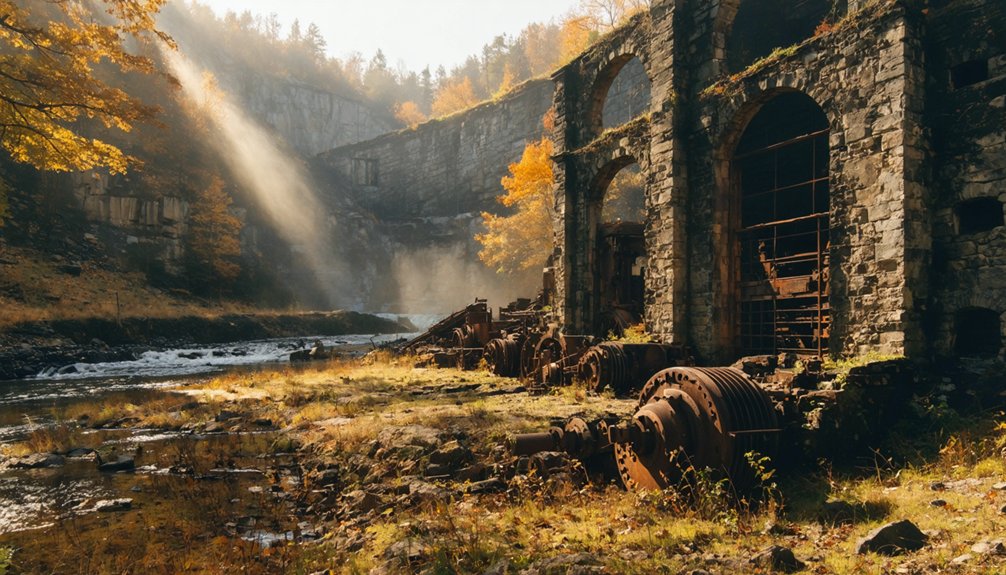
The dramatic contrast between Rush’s industrial past and natural splendor creates a uniquely compelling ghost town experience.
You’ll find this historic mining district nestled within the Buffalo National River area, where natural preservation meets mining heritage in a striking display. The rugged Ozark landscape, with its towering bluffs and dense forests, now embraces the remnants of Rush’s zinc mining era, offering you a chance to explore both history and wilderness.
- Hike through preserved mine sites while spotting diverse wildlife in their natural habitat
- Discover old mining equipment against the backdrop of scenic river valleys
- Camp nearby to fully immerse yourself in the area’s rich historical atmosphere
- Explore the town’s remaining structures amid the recovering ecosystem
- Follow marked trails that showcase both industrial artifacts and natural formations
Walking Through Time: Trail Discoveries
While exploring Rush’s historic mining district, you’ll discover an intricate network of trails that weave through the remnants of this once-bustling zinc mining community.
The Morning Star Mine Loop Trail serves as your gateway to the past, with interpretive signs revealing stories of the smelter and livery stable. For a deeper journey, you can trek the 2.8-mile Rush Mine Level Trail, where abandoned mine entrances whisper tales of World War I prosperity.
Practice good trail etiquette as you navigate the Monte Cristo Trail, which offers flexible routing through varied terrain.
Each path delivers its own historical storytelling experience, with clear markers guiding your way through the Buffalo National River Park. Whether you’re a casual walker or experienced hiker, you’ll find a trail that matches your adventure level.
Frequently Asked Questions
Are There Any Reported Ghost Sightings or Paranormal Activity in Rush?
While you might expect spooky tales from abandoned mines, there aren’t any documented ghost stories or paranormal investigations in Rush. You’ll find rich history, but no credible reports of supernatural activity.
What Was the Total Value of Zinc Extracted During Rush’s Mining Operations?
You can’t pinpoint the exact total value, but zinc production was worth millions in historical dollars, with mining statistics showing over $1 million from concentrates in 1916 alone.
How Dangerous Were the Working Conditions in Rush’s Mines?
Walking through death’s door daily, you’d face mines with zero safety regulations, constant disease exposure, and deadly equipment hazards. Miners battled typhoid pneumonia and respiratory problems without protection.
Can Visitors Collect Mineral Specimens or Artifacts From the Site?
You can’t legally collect minerals or artifacts at this federally protected site. It’s prohibited by National Park Service regulations to preserve historic resources for future generations to study and appreciate.
Were There Any Major Mining Accidents or Disasters in Rush’s History?
While mining safety was generally good, you’ll find one notable disaster: the 1916 Ben Carney mine collapse killed two miners. Historical incidents were mostly isolated, with Sebran Wiggins’ 1887 mining-related illness being another casualty.
References
- https://www.katepantier.com/discover-the-ghost-town-of-rush-arkansas-hidden-historic-gem/
- https://www.barefoottraveler.com/rush.html
- https://www.youtube.com/watch?v=DSwT-EmfJEc
- https://somewhereinarkansas.com/ghost-town-of-rush-arkansas/
- https://en.wikipedia.org/wiki/Rush_Historic_District
- https://cast.uark.edu/hicks.php
- https://www.arkansas.com/articles/ghost-town-rush
- https://encyclopediaofarkansas.net/entries/rush-ghost-town-marion-county-1270/
- https://en.wikipedia.org/wiki/Rush_Creek_mining_district
- https://www.nps.gov/buff/learn/kidsyouth/overcoming-obstacles-at-rush.htm
